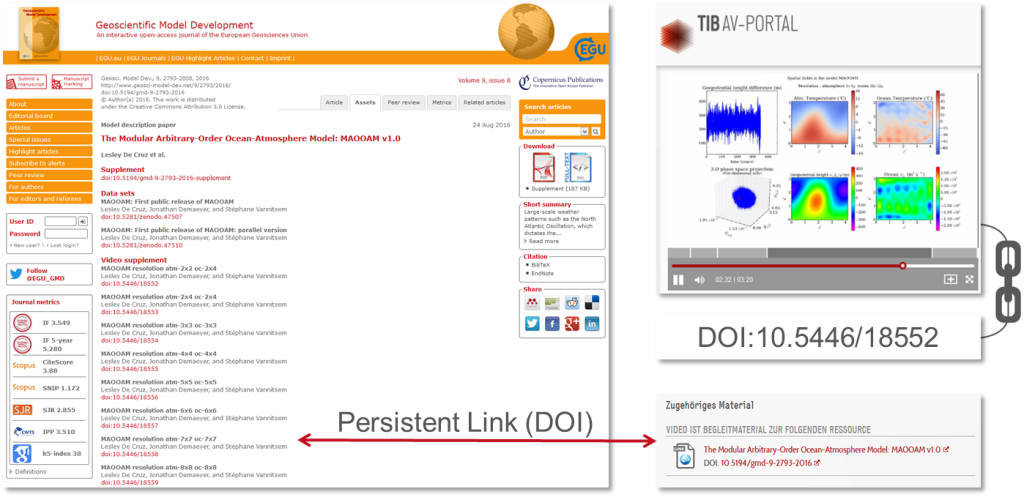“The TIB AV-Portal offers all the features our authors need to host their videos” – an interview with Xenia van Edig.
One and a half year ago Copernicus Publications and the Technische Informationsbibliothek (TIB) ‒ German National Library of Science and Technology partnered to provide authors who publish in Copernicus’ open access journals with the opportunity to host their videos in the TIB AV-Portal and link them to their articles and vice versa via DOI. I spoke to Dr. Xenia van Edig from Copernicus Publications about the importance of scientific videos and her experiences from this collaboration.
Xenia van Edig. From a publisher’s point of view, what role do scientific videos play when accompanying scientific articles (e.g. video abstracts or supplemental videos)?
Video abstracts provide an additional access point to an article. Thus, they enhance its visibility and therefore support an important goal of open access publishing. Video supplements offer the opportunity to visualize research findings or applied methodologies. Scientists can use them for example to display different model scenarios or to show processes like soil erosion.
Video supplements can not only contain supplementary information, but can also be multimedia figures within the article. We at Copernicus regard the scientific article as only one part of the scientific output. We see the outcome of a scientist’s work as a publication cluster. The journal paper is the trunk and data sets, model code, videos, and other underlying or related materials are the branches. It is very important that the preservation of these different objects is long term and that they are linked to each other ideally through digital object identifiers (DOIs). We provide our authors with the opportunity to connect their different research outputs through an assets tab which can be displayed together with the article.
How will the meaning of videos for the scientific publishing process change in the next years?
The importance of videos is growing in all spheres of society. A report created by Cisco in 2016 estimates that by 2020, internet video streaming and download will account for 80% of all consumer internet traffic. I think videos will also become more important in scientific research and the related publications.
How can authors and publishers benefit from publishing videos that are related to their work and their articles?
Authors can get additional attention for their works; publishers can enrich the content they are providing as well as their service portfolio for authors; and readers can benefit from additional information and non-textual resources. These additional resources may enhance the traceability of scientific finding not only for other researchers of the same field but also for the growing number of researchers whose work is inter- and multidisciplinary. Explaining the context visually can help them. This effect is also very important for interested laypersons.
What tools and infrastructures are required for publishing scientific videos?
On the one hand, publishers usually have a very good technical infrastructure to host textual resources such as scientific articles or books. However, this does not imply that their infrastructure is likewise suited for other file types such as videos. On the other hand, easy-to-use media such as YouTube do not guarantee long-term availability and preservation, which are crucial for scientific outputs. In addition, no licences which are appropriate for scientific outputs are provided. Therefore, scientific videos should be hosted in reliable and dedicated repositories. These platforms provide a suitable infrastructure for hosting and displaying videos.
What should a platform for scientific videos offer to publishers and authors?
A platform should be easy to use and should provide reliable services. It should have a preservation strategy and should assign persistent identifiers to the deposited objects. Ideally both outputs, the scientific article and the corresponding video, receive a DOI which enables sustainable interlinking (in contrast to URL links, which often have a short lifetime) and citation. In addition, a platform should be free of charges and comfortable for authors to use. There should be no barriers that hinder the author from publishing their content. For publishers it is also important to have an interface for the cross-linkage between videos, articles in journals, and other assets.

Why do you publish video abstracts and video supplements on the TIB AV-Portal?
The TIB is an ideal partner. The TIB AV-Portal offers all the features our authors need to host their videos. They can choose the appropriate licence for their video, ideally a Creative Commons licence. It is great that the videos related to our journals fit into the subject areas the TIB is collecting. A very crucial aspect for us is that the videos get a DOI and can even be cited sequence-wise. The DOI also enables interlinking: the TIB links back to the article published at Copernicus and the article links back to the video. The TIB is also a reliable partner in terms of preservation.
Looking back on one and a half years of collaboration between Copernicus and the TIB AV-Portal: What is your résumé and what are your expectations for the future?
We regard our collaboration as extremely successful. Authors have already uploaded more than 70 videos to the TIB AV-Portal. The videos are linked to various articles from different subject areas in numerous journals with individual communities. In addition to the videos hosted in the TIB AV-Portal, some authors have also used other repositories to deposit their videos.
Prior to our collaboration, we were only aware of nine videos which were connected to one journal. Of course, it might be that more videos were hidden in supplements. However, the increase in video deposition that we are aware of has increased tremendously.
The vast majority of the videos which are deposited in the TIB AV-Portal are video supplements. Thus, video abstracts require greater advertising.
If more and more authors make use of this opportunity, we will need to create a technical interface for the linking between the article and its corresponding video and vice versa. At the moment, we inform the TIB via email whenever an article that includes a TIB DOI in its assets is published. In order to obtain the video DOI, we ask authors during the production file upload to provide us with the DOIs of their data sets, their model code, their videos, etc.
At the moment, the articles and their videos are linked via an asset tab (see for example http://www.geosci-model-dev.net/9/2793/2016/gmd-9-2793-2016-assets.html). In the future, Copernicus articles will also be available as full text HTML. This will provide the opportunity to incorporate videos as multimedia figures and also to better embed video abstracts.
About Copernicus Publications:
Dedicated to open access, Copernicus Publications publishes 38 highly reputable peer-reviewed scientific journals that are freely available online. The German company has been a partner of scientists and societies since 1988 and launched its first open access journal in 2001. It has played a leading role in the development of Interactive Public Peer Review and is a founding member of the Open Access Scholarly Publishers Association (OASPA). With a clear focus on in-house services, Copernicus promotes the work of scientists worldwide in the most personal and effective way.
About Dr. Xenia van Edig
Since the beginning of 2012, Xenia has been working in Business Development at Copernicus Publications. At Copernicus, she is responsible for the acquisition and development of new journals. She is also involved in Copernicus’ media and communications activities and the indexing of the journals. In addition, she is in charge of establishing institutional agreements regarding the central settlement of article processing charges (APCs) between various institutions and Copernicus. Since September 2015, Xenia has been a member of the board of directors of OASPA. The mission of OASPA is to support and represent the interests of open access journal and book publishers globally in all scientific, technical, and scholarly disciplines. Xenia chairs OASPA’s membership committee.
... arbeitet im Kompetenzzentrum für nicht-textuelle Materialien (KNM).




6 Antworten auf ““The TIB AV-Portal offers all the features our authors need to host their videos” – an interview with Xenia van Edig.”